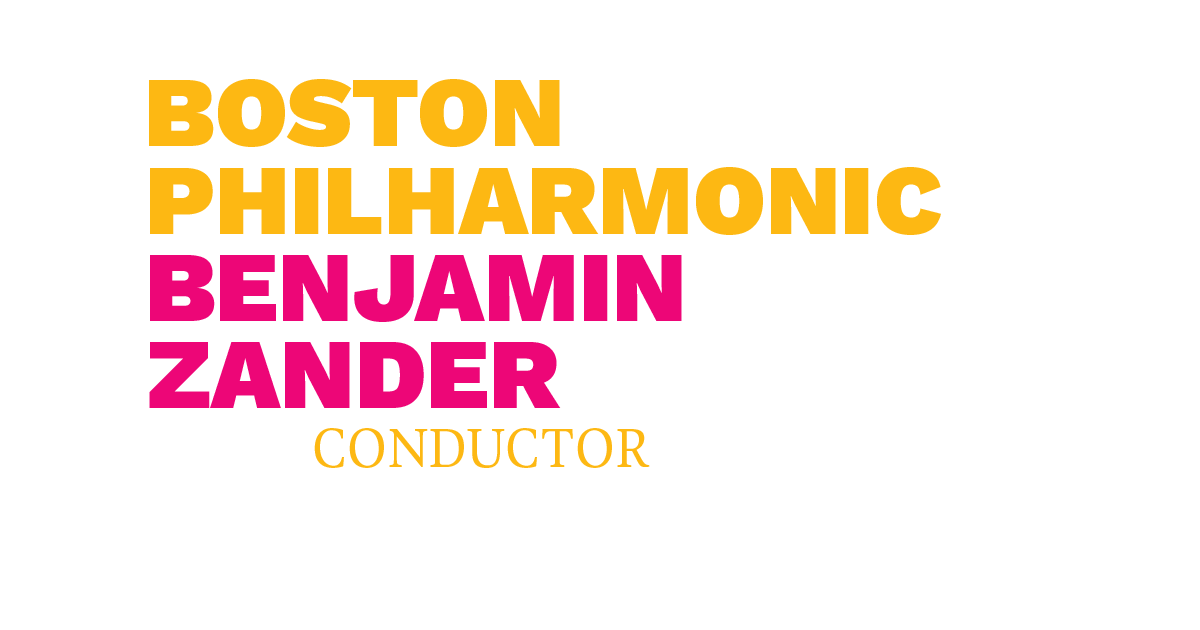Stories from the Road - Volume 1
Boston Philharmonic Youth Orchestra2017 South American Tour
 Photo Credit: Paul Marotta
Photo Credit: Paul Marotta
Lima, Peru - All the glamor and adventure have evaporated from most travel, but destinations retain all their magic and allure. Anyone can learn something from destinations, which is what the Boston Philharmonic Youth Orchestra plans and expects to do during its tour to three countries in South America; the musicians and their music director, Benjamin Zander, will watch, listen and learn in a spirit of eager inquiry; they will teach others, each other, and themselves as they learn from the people, places, landscapes and experiences they encounter along the way.
Saturday was the first day of the BPYO’s tour to South America, which the organization has again described and defined as a "tour of possibility" - a phrase emblazoned on hundreds of red t-shirts proudly worn by the players; more to the point, the tour has been structured to encourage musical and personal explorations of positive possibilities. From the first pre-tour meeting of the entire ensemble in Boston, conductor Benjamin Zander, forbade anyone to “disappear” by sitting in the back, and later on urged that the musicians spend at least an hour a day talking to colleagues they don’t already know personally.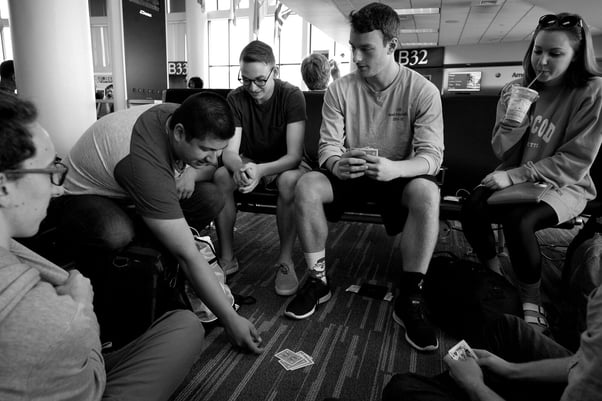
Photo Credit: Paul Marotta
This first day was a travel day so it was limited in possibilities, although the group made the most of them, and after we arrived in Lima the American Airlines cabin crew made a point of telling the tour staff that it was one of the nicest large groups they had ever worked with. Imagine saying that about a group of 105, most of them teenagers.
Nor was Saturday the beginning of the tour in anything other than a calendar kind of way. Advance planning had begun even before last summer's tour through Spain, and senior advisor Mark Churchill, managing director Elisabeth Christensen, and Zander had dealt with thousands of details in a situation that each of them knew would also inevitably provide countless opportunities for improvisation to bubble up.
String basses are cumbersome and expensive to travel with, so the BPYO needed to rent instruments in each of the three countries on the tour, Peru, Argentina and Uruguay; the players brought their own bows. Cellos were packed into protective metal cases that were checked as baggage; here they travel by bus and truck from airport to hotel, and from hotel to venue. They ghostly white metal cases line up backstage or in a hotel hallway like silent sentinels at an ancient shrine. And Christensen had to know her way around an infinite number of obstacles; it is her way to construe an obstacle as an opportunity. Just one tiny example: the creators of valuable older instruments and bows often used ivory in their construction and decoration. Today someone must submit a lot of paperwork if he doesn’t want an instrument or bow to be seized and confiscated by customs officers.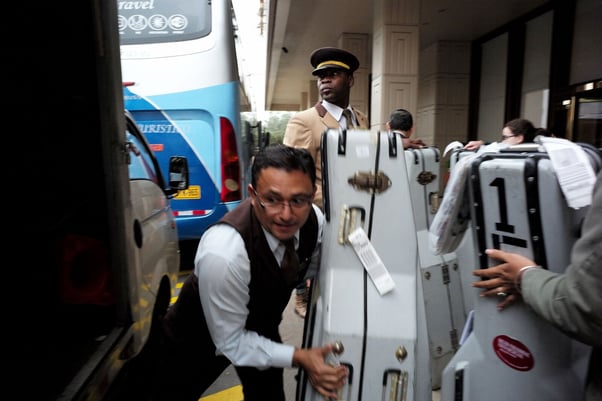
Photo Credit: Paul Marotta
And of course the group itself had to make numerous time-consuming preparations; packing a suitcase, making sure you have enough socks, and underwear and grabbing your instrument and music is the least of it. The players come from all over New England and even from as far as New York City for a four-hour rehearsal every Saturday throughout the season and prepare three full concert programs from which most of the tour repertoire is drawn. A challenging event of the season just past was Mahler's Sixth Symphony, a work seldom in the repertory of any youth orchestra anywhere; the many-splendored performance in Boston's Symphony Hall is now officially available on CD or as a download. Repeating that tremendous achievement on tour would be tricky, and costly, because it requires so many additional players and instruments, so Zander decided to substitute Franck's once popular, now rarely heard, Symphony in D Minor, the first symphonic work he ever played in as a child cellist in England more than six decades ago. "Walter Susskind, a wonderful musician, was the conductor and I was overwhelmed to be in the middle of all that sound. When we arrived at the glorious climax of the work at the end, which brings together everything that has come before, I looked at Susskind and I saw that tears were streaming down his cheeks, and I thought, 'I want what he is having!'" For more than 50 years now Zander has had it – and shared it. But he did wait until the 1970s to conduct the Franck Symphony, just once, and he hasn't scheduled it since.
Once the Boston season was over, Zander and the young players devoted a special series of rehearsals in the Benjamin Franklin Institute of Technology and the Fenway Center at Northeastern University to refresh and polish the tour repertory - about 24 hours of meticulous group work leading up to a send-off concert in Sanders Theater that repeatedly brought the audience to its feet, whooping approval. One of the musicians wrote to Zander that this was the best concert she had ever participated in - it will be interesting to ask her at the end of the tour just what the experience of each additional performance has taught her.
That's one of the many advantages of touring - the opportunity to develop new standards through multiple performances. Major orchestras usually play each program three or even four times. Two possibilities then arise: matters can settle into a high-level professional routine, which means nothing much is going to happen, or the performance will change and grows over the course of a series - not to mention what can happen under a dedicated music director or beloved guest conductor over a period of several seasons. Youth orchestras and orchestras and schools spend weeks or even months rehearsing and then there is just one concert before moving on to the next project. Now the BPYO will play Prokofiev's Fifth Symphony four more times, and each performance will provide an opportunity to build on its predecessors.
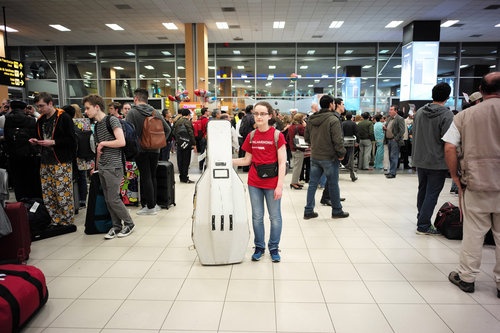
Photo Credit: Paul Marotta
This blog hasn't even brought us to Logan Airport yet and it is time to get there. The BPYO travelled in two groups, the first of which met at 6:30 AM Friday and travelled to Lima, Peru via Newark, New Jersey. Group two met at 8 AM and flew to Peru via Miami. The plan had left plenty of time to check in, pick up your cello if you were a cellist, pass through security, and get to the gate. On previous tours there have sometimes been impromptu concerts in the waiting area; this time there were a couple of cutthroat card games in progress. And before the boarding call, the first crisis had come to light: one key player from group 2 wasn’t there yet; indeed he missed the plane, but the story had a happy ending, and the musician in Peru a day late but in time to jump into the schedule and participate in the first public concert.
Flying is now a fairly grim grey experience. Every time I go to an airport I remember my excitement at my first flight 54 years ago - Cleveland to Detroit, when I was enroute to the National Music Camp at Interlochen. I dressed up in coat and tie, as if I were on my way to church, believe it or not. That little flight was probably spacious compared to the way passengers are packed in and confined now - I thought darkly about how the person who designed the cabin area should be strapped into one of those middle-of-the-row seats and sent to Australia and back with only a few of American Airlines’ bagged “tropical snacks” to sustain him. These little packets sound healthy but they contain a longer list of chemicals than of foods, and just when did Scotch shortbread become tropical?
The Miami group ran into trouble because Air Force One was delivering the President to Florida that day, so all other planes had to trace oval flight patterns for nearly an hour before they could land. That meant a breathless rush to get from the arrival area to the distant gate for the longer flight; the longer flight was uneventful except during intermittent moments of turbulence which more than eventful enough.
The movie might have won parental approval - it was the recent remake of Disney's Beauty and the Beast. I decided to skip listening to it because I must have seen the cartoon 20, or 200, times when my twin niece and nephew were little. Occasionally I looked up hoping to glimpse le Fou - Disney's first openly gay character - 17 years into the 21st century. He appears in a scene dancing with his dragoon – an episode that led to the film’s being banned in Kuwait and Maylasia, and one town in Alabama. Maybe American Airlines decided to spare its inflight audiences, but it’s more likely that I slept straight rough it.
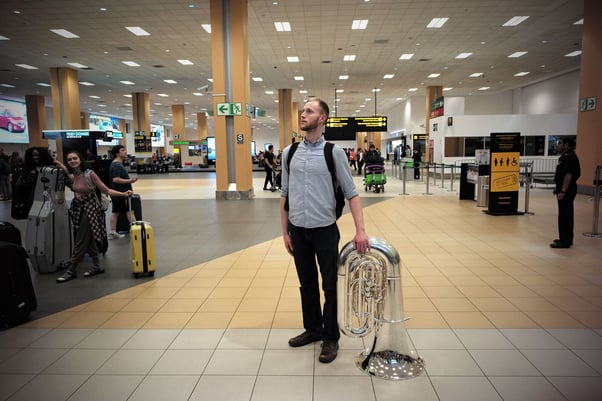
Photo Credit: Paul Marotta
Group two arrived in Lima's airport late in the evening. After the formalities at immigration and the baggage area, the tour musicians into a huge crowd in the lobby; someone amidst the throng, probably a driver, waved a sign that welcomed BENJAMIN ZANDER. Once outside we made our way to the busses that would take us through what we were told was a typical Friday-after-midnight traffic jam in Lima to our first temporary lodging, a large and handsome Sheraton Hotel in the Plaza of the Republic across the street from the Peruvian Supreme Court.
It wasn't possible to gain much of an impression of Lima - and it would be difficult to develop any single impression of a city this vast and teeming with activity. The capital of Peru is the third largest city in the Americas, and 11 million people live here; the land area is more than 1000 square miles! But it was intriguing to think about a few similarities and differences between Lima and Boston.
The nearby ruined temples at Pachacamac were an important destination for pilgrims for 1300 years before the arrival of the Spaniards, so the history of Lima as a city goes back centuries and millenia before Francisco Pizarro officially “founded it” in 1535. A giant equestrian statue of the bloodthirsty Spanish conquistador, three times life-sized, once stood in the most prominent public space in the city, in front of the cathedral. Now it has been placed in an inconspicuous park next to the main railroad terminal. No longer does a stately pedestal proclaim the name of the sword-wielding horseman – Pizarro’s sword destroyed the Inca civilization which is now a proud part of Peru’s history. The national soft drink, made by Coca-Cola, is called Inca Cola; it is radioactive yellow and tastes like bubblegum.
New England was inhabited but not by humans living in cities, long before Puritans from England established Boston in 1630, almost a century after Pizarro established Lima about 3776 air miles to the south, although Pizarro would have had no way of comprehending that distance – or statistic. The oldest university in South America, San Marcos, in Lima, was created in 1551; Harvard, the oldest in North America, dates back to 1636. Both cities have experienced turbulent and revolutionary times. Lima is currently thriving, but its most recent period of lawlessness, corruption and massacres ended only in the 1990s. America, on the other hand, seems to be entering a particularly dangerous and divisive period, but let’s not go there, and instead return to the Sheraton Hotel.
The 18 floors of rooms are reached by balconies that enclose a huge, empty rectangular atrium that it is unsettling to look down upon from above. But the players of the BPYO are always alert to possibility: the mezzanine floor looked like a spectacular spot for a frisbee tournament, and the next night it happened...
